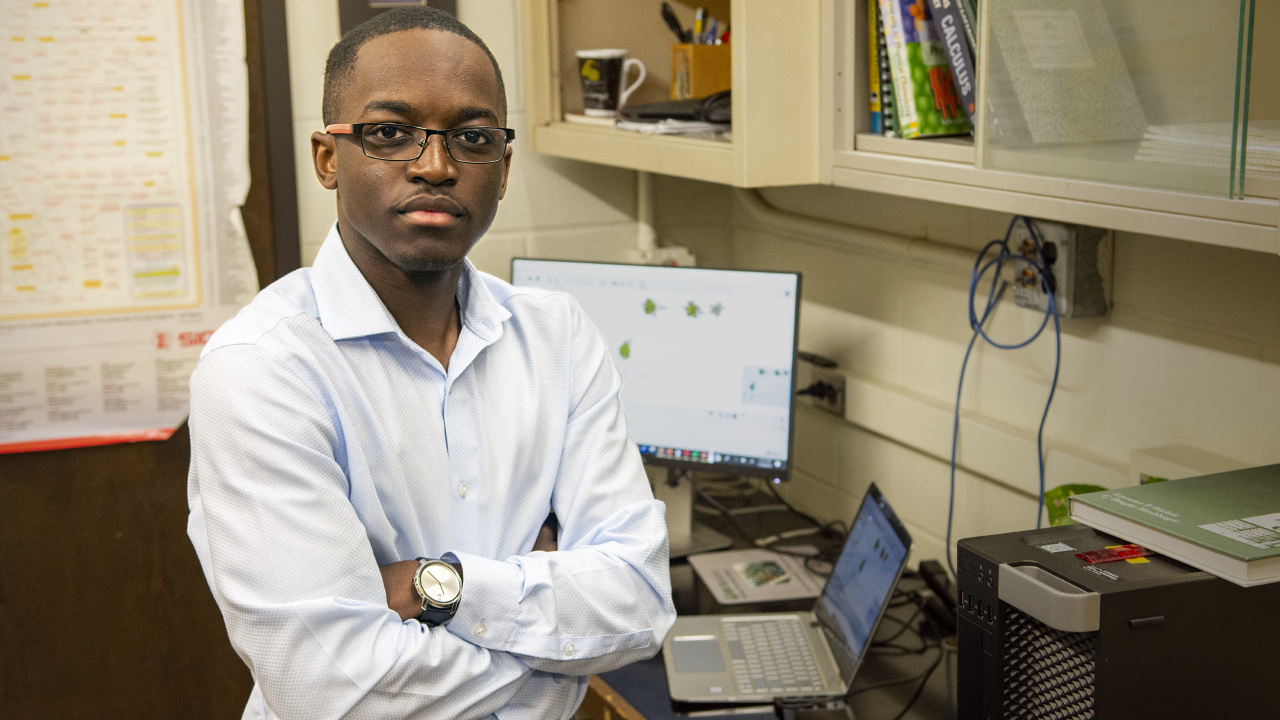
Kovic Odhiambo working in the Wackett Lab in the College of Biological Sciences. Photo: UMN/Holly Santiago
This summer, University of Minnesota junior Kovic Odhiambo has been poring over computational data on bacteria, searching for a few genes that could set the stage for more eco-friendly fertilizers.
“We’re looking at the specific sequences within the bacteria,” he said. “We’re looking to see the abundance of these genes in each different phylum, and what environments they exist in.”
Odhiambo, a statistics major from Brooklyn Park, Minnesota, is one of 14 students participating in a summer research internship offered through a collaboration between the North Star STEM Alliance and the state-funded MnDRIVE program. North Star STEM, part of a network of similar programs funded by the National Science Foundation, provides academic support, undergraduate research, and professional development to underrepresented minorities in Minnesota working toward bachelor’s degrees in the fields of science, technology, engineering or math (STEM) fields.
Anne Hornickel, North Star STEM director, said the opportunity to conduct research in a laboratory or field setting complements the curriculum students encounter in their courses, while giving them a new way to think about the concepts they have learned.
“Undergraduate research is a rich experience for how it delves into scientific content that students may have had in class,” she said. “They get to approach it differently, asking questions to discover what is not known and working closely with graduate students and post-doctoral researchers. This becomes their initial experience with professional science communities.”
North Star STEM and MnDRIVE first teamed up on environment-related research internships in 2015. Since then, with help from faculty and staff in several disciplines, the collaboration has expanded to include all four of the original MnDRIVE research areas: Brain Conditions, Environment, Global Food, and Robotics. Through the collaboration, North Star STEM provides a stipend to each intern, with additional funding from MnDRIVE to cover lab supplies.
In addition to providing valuable hands-on experience and building students’ knowledge base, Hornickel said, participating in North Star STEM can also reinforce students’ interest in, and commitment towards, their major and their larger career goals.
“Research is especially effective at retaining students in STEM majors,” she said. “They get excited to work on the edge of new knowledge, they learn their subject matter more deeply, and they begin to work in a science community. All three aspects begin to build students' science identities. By feeling like they are contributing and belonging to a science community, they are more motivated to complete the bachelor's degree and go beyond it.”
A Few Good Genes
Before participating in the North Star STEM and MnDRIVE research internship, Odhiambo knew he needed to gain some experience working in a lab. He wanted to pursue a career in biotech entrepreneurship after graduation, but he knew that a background in the subject matter would help him build credibility with investors and get them on board.
“I needed some hands-on research before then, so I could understand how the industry is run,” he said.
After reaching out to professors in CBS and the BioTechnology Institute, Odhiambo was ultimately introduced to Larry Wackett, PhD, Distinguished McKnight University Professor of biochemistry, molecular biology, and biophysics in the College of Biological Sciences. Wackett’s research has focused on bioinformatics to find ways, for example, to break down chemicals contaminants in water, and the data science involved appealed to Odhiambo. Wackett offered him a position in his lab.
This summer, North Star STEM and MnDRIVE made it possible for Odhiambo to continue this role in Wackett’s lab. The current research focuses on hunting down species of bacteria that have certain genes in them, including one known as “atzD,” that can create enzymes to break down biuret into urea—a form of nitrogen fertilizer used to grow crops.
That’s potentially a huge benefit, because the presence of these bacteria and their enzymes in the soil could allow farmers to use alternative fertilizers that come in larger pellets less prone to runoff. The advantages would be twofold: not only would the fertilizer be less likely to contaminate waterways, but it would also be more efficient—with the pellets sticking around in the soil longer, crops could absorb a larger portion of the urea and benefit from the nitrogen it supplies.
“Our newest research paper is going to be looking at the data set to see what it tells us about the bacteria that are in the environment in regards to atzD and some other genes that we’re looking for,” Odhiambo said.
In this project, his role is computational. He has been putting his statistics background to work analyzing data sets of bacteria samples to determine where in the environment the atzD gene appears in the highest concentrations. Ultimately, the research could inform scientists’ efforts to cultivate colonies of bacteria that have the desired genes and use them to grow crops while lowering the amount of fertilizer that contaminates nearby waterways.
For Odhiambo, the research experience has been invaluable not only in applying concepts from his classes, but in preparing him for his future aspirations, which potentially include a master’s degree in bioinformatics and a career in biotech.
“I’ve always loved science and biotechnology,” he said. “Now that I understand the inner workings of the lab, I can see how people collaborate and how people relay information to one another.”